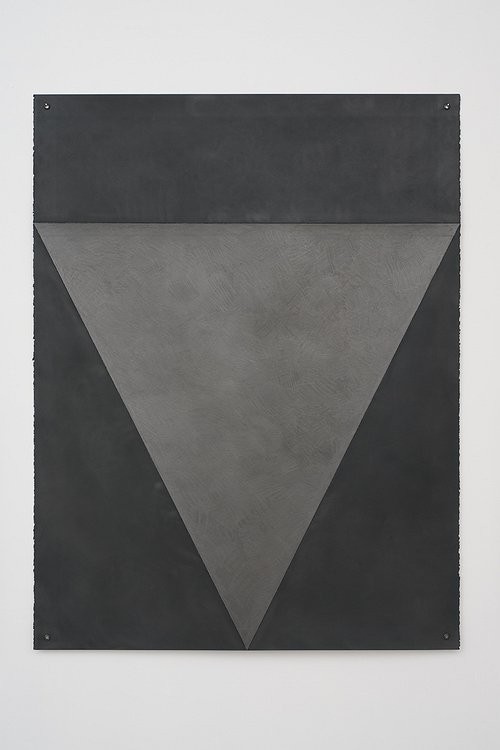Dan Shaw Town
29 Oct - 17 Dec 2011

© Dan Shaw Town
Untitled, 2011
Graphite and Enamel Spray Paint on Paper with Metal Grommets
50 x 38 inches (127 x 96.5 cm)
Untitled, 2011
Graphite and Enamel Spray Paint on Paper with Metal Grommets
50 x 38 inches (127 x 96.5 cm)
DAN SHAW TOWN
29 October - 17 December, 2011
Dan Shaw Town’s exhibition consists of wall and floor based work that occupies a space somewhere between drawing and sculpture. Each piece begins with dense, graphite covered paper sheets, which are then folded, kneaded and creased to create varying surfaces and compositional markings. The artist uses spray paint as a ‘primer’ for the graphite, or as a ‘finish’; in either case the spray becomes a tool that simply affects the graphite rather than interjecting as an autonomous accompanying medium.
The larger wall-hung works focus on two of Modernism’s fundamental shapes: the Square and the Triangle, two tropes that are both universal and accessible. Shaw-Town is interested in introducing this familiar visual language in his work as an analog for ready-made, a template from which to develop ideas and techniques concerned with displaying a process of personal manufacture. These works promote an unorthodox handling of the paper in a bid to create a new approach to drawing.
The smaller wall-hung works display varying stripe and chevron patterns, a recognized aesthetic that recalls hard-edge minimalist painting as much is does folk art textiles. Shaw Town draws from these early folk antecedents to imbue the cool, semi-industrial surfaces with a sense personal gesture and particularity. He tempers the variability of paper folding and crumpling with the restrained precision of measured line to explore how the medium reacts to various treatments, applied uniformly. Through this, pattern is cited as a systematic way of covering a page, inviting the viewer to consider the material and the transformation it undergoes.
Also on display are layered arrangements of partially obscured table works, suggesting their purpose as rejections or failed drawings best presented as concealed objects. Here, the paper sheets are folded in several ways, exploring the characteristics of the material in terms of its weight and elasticity. The paper here functions as a sculpture, and the folds themselves impart the viewer with a sense of physical gravity that could perhaps not have been communicated as plainly in any other material. There is a slightly unsettling tension in knowing that what may appear as a temporary moment in these objects is indeed a final resting point. These sculptures with their material flatness and repose suggesting that they are as much concerned with potentiality as they are anything else.
29 October - 17 December, 2011
Dan Shaw Town’s exhibition consists of wall and floor based work that occupies a space somewhere between drawing and sculpture. Each piece begins with dense, graphite covered paper sheets, which are then folded, kneaded and creased to create varying surfaces and compositional markings. The artist uses spray paint as a ‘primer’ for the graphite, or as a ‘finish’; in either case the spray becomes a tool that simply affects the graphite rather than interjecting as an autonomous accompanying medium.
The larger wall-hung works focus on two of Modernism’s fundamental shapes: the Square and the Triangle, two tropes that are both universal and accessible. Shaw-Town is interested in introducing this familiar visual language in his work as an analog for ready-made, a template from which to develop ideas and techniques concerned with displaying a process of personal manufacture. These works promote an unorthodox handling of the paper in a bid to create a new approach to drawing.
The smaller wall-hung works display varying stripe and chevron patterns, a recognized aesthetic that recalls hard-edge minimalist painting as much is does folk art textiles. Shaw Town draws from these early folk antecedents to imbue the cool, semi-industrial surfaces with a sense personal gesture and particularity. He tempers the variability of paper folding and crumpling with the restrained precision of measured line to explore how the medium reacts to various treatments, applied uniformly. Through this, pattern is cited as a systematic way of covering a page, inviting the viewer to consider the material and the transformation it undergoes.
Also on display are layered arrangements of partially obscured table works, suggesting their purpose as rejections or failed drawings best presented as concealed objects. Here, the paper sheets are folded in several ways, exploring the characteristics of the material in terms of its weight and elasticity. The paper here functions as a sculpture, and the folds themselves impart the viewer with a sense of physical gravity that could perhaps not have been communicated as plainly in any other material. There is a slightly unsettling tension in knowing that what may appear as a temporary moment in these objects is indeed a final resting point. These sculptures with their material flatness and repose suggesting that they are as much concerned with potentiality as they are anything else.
